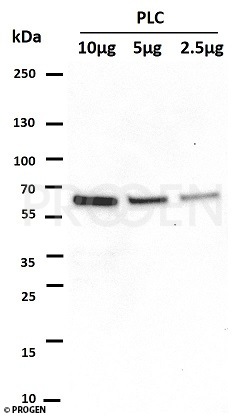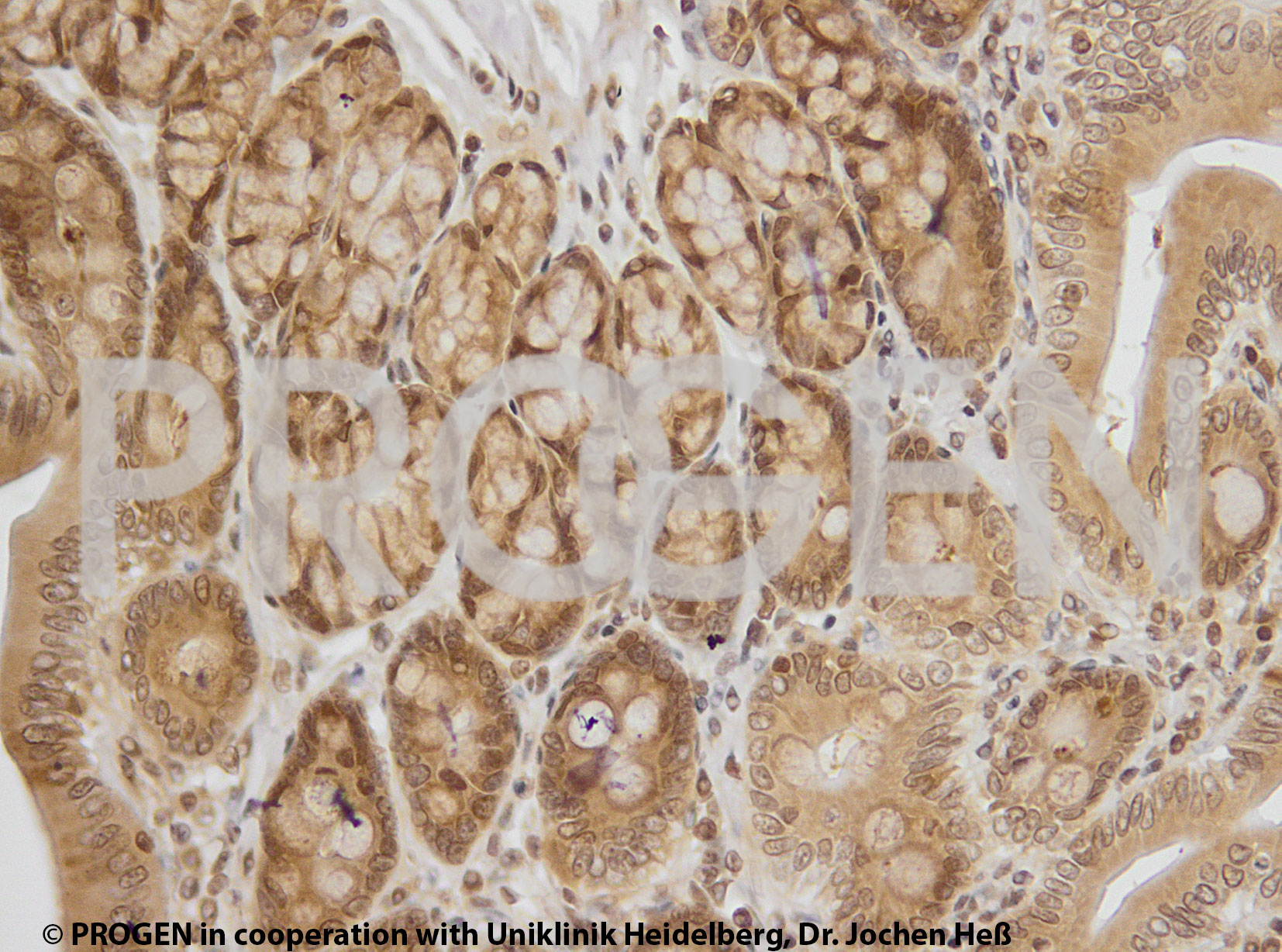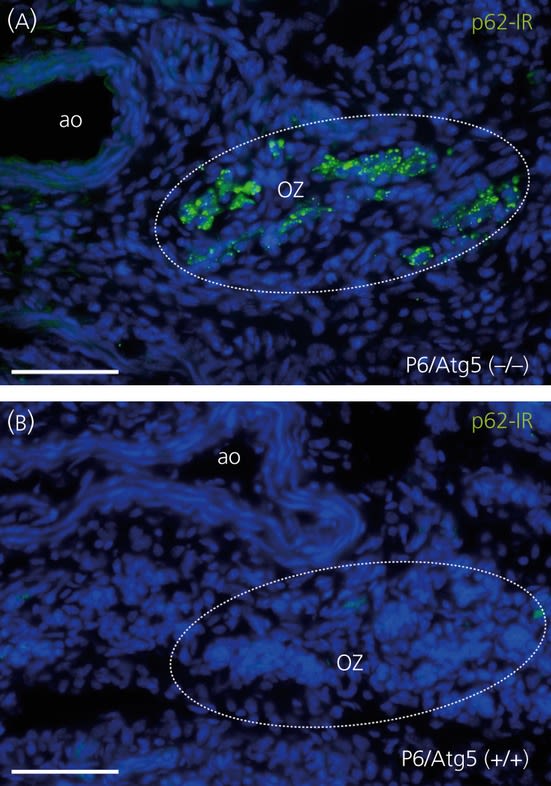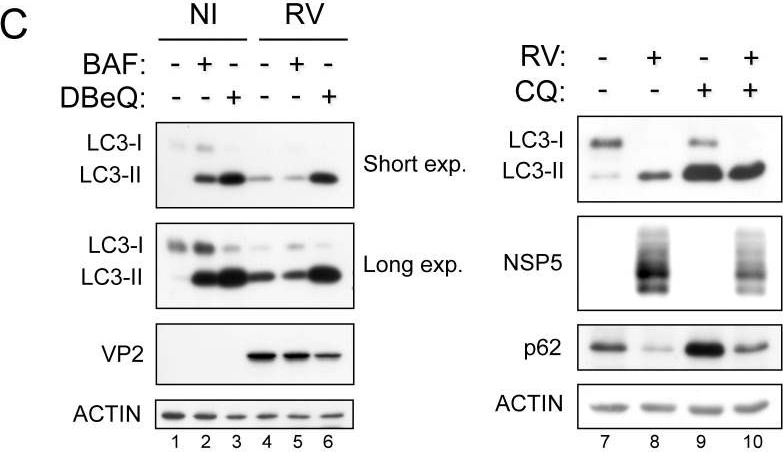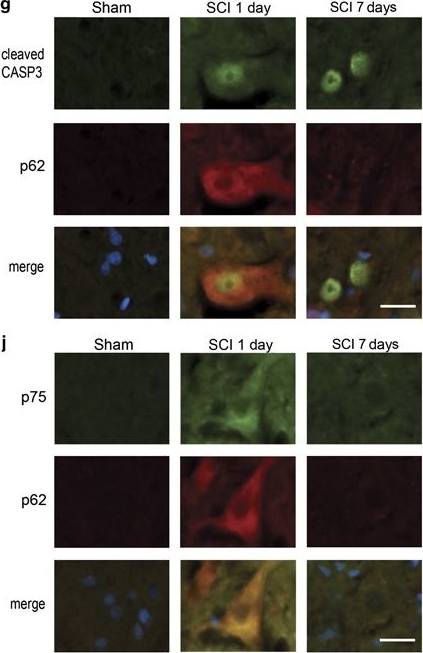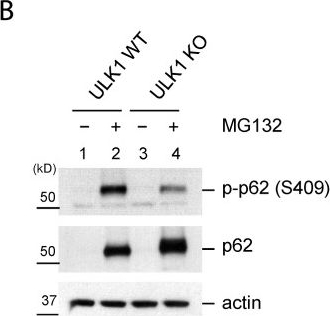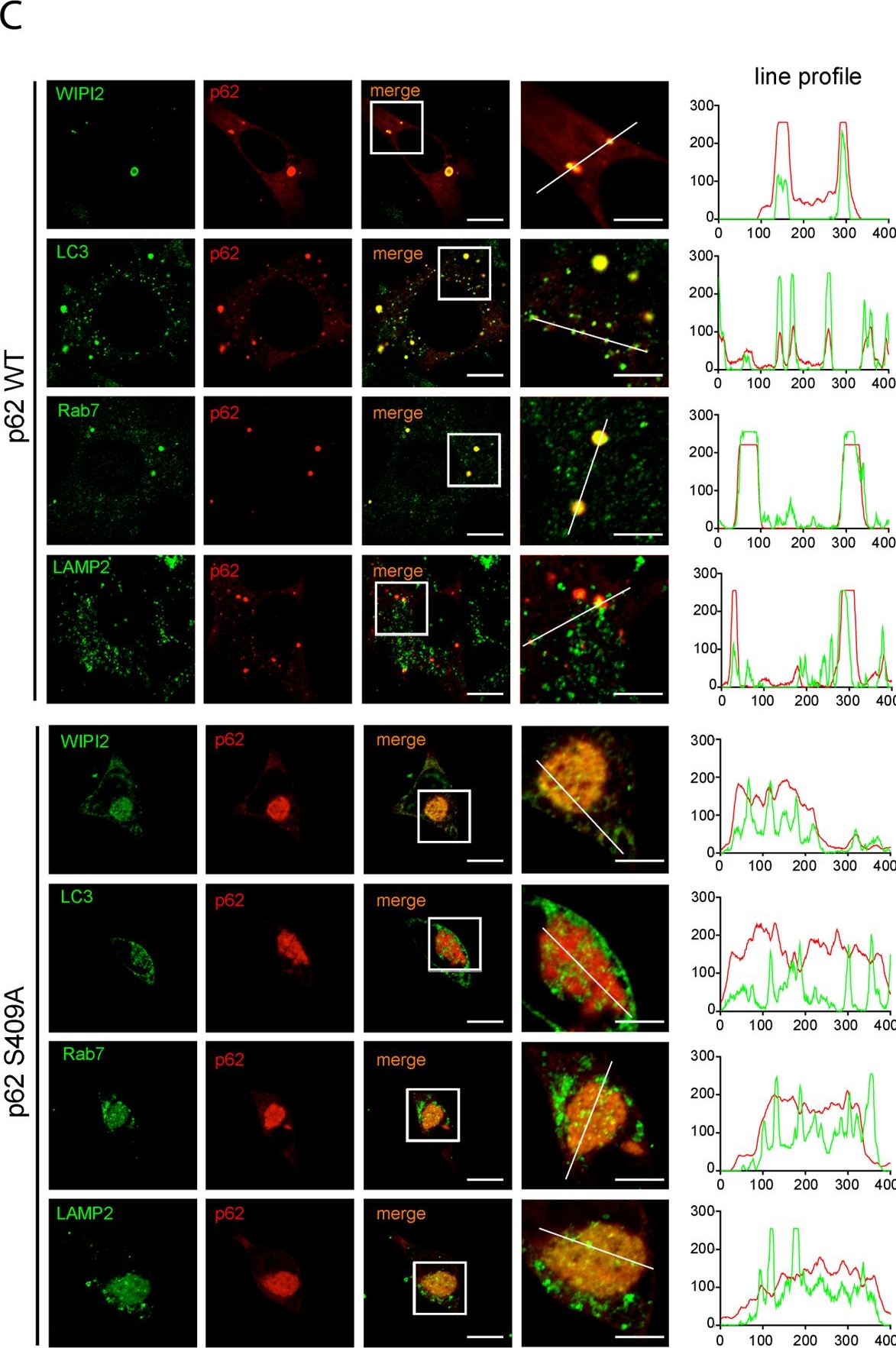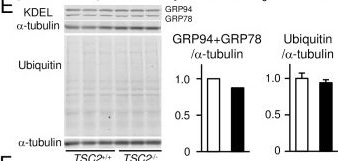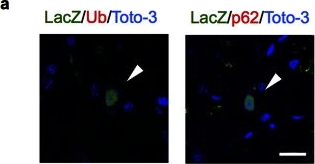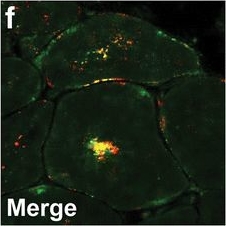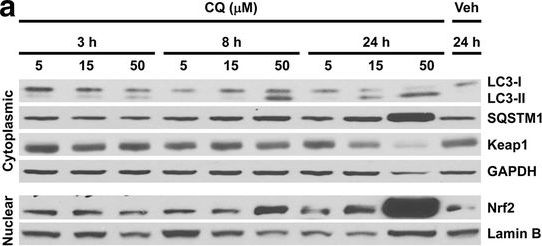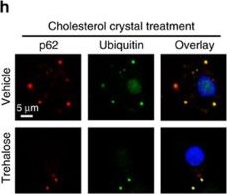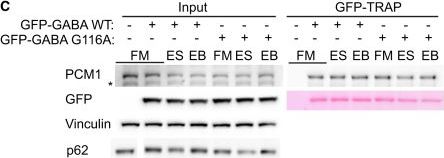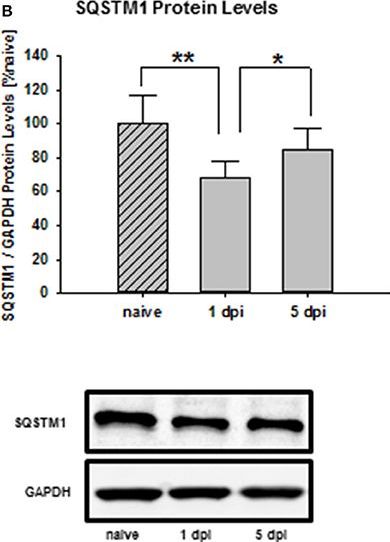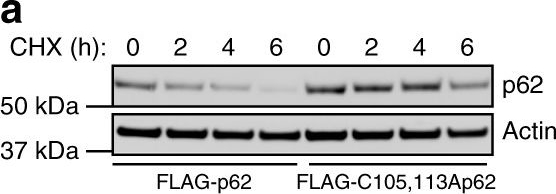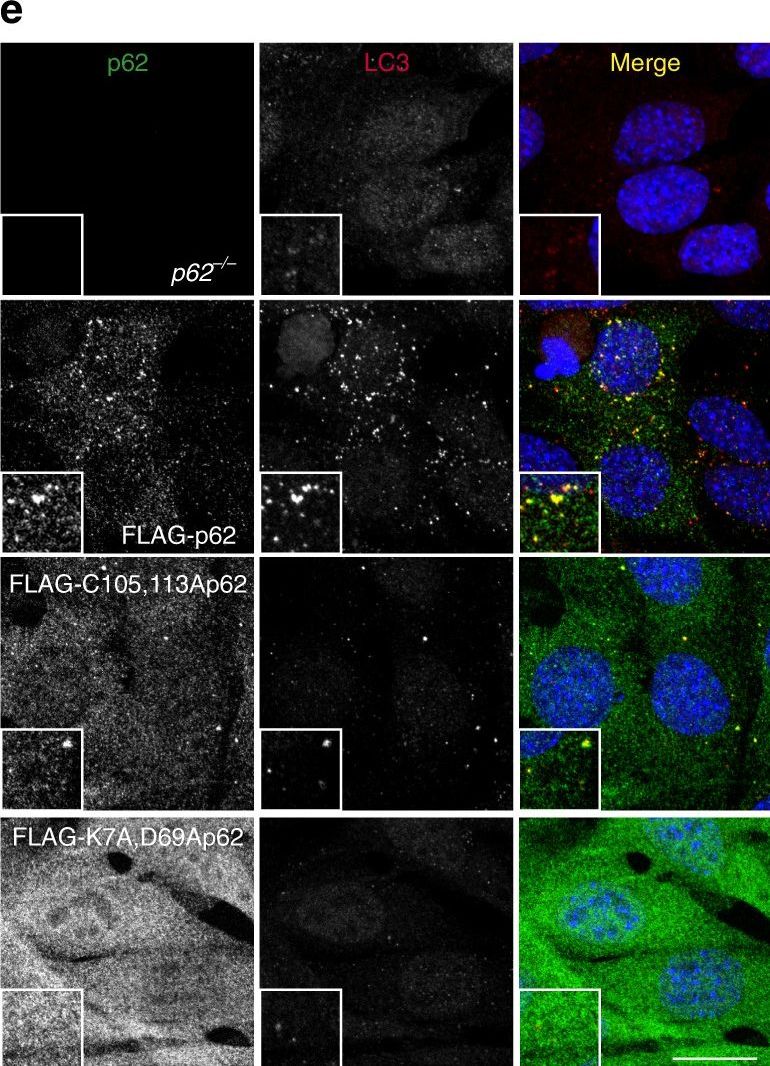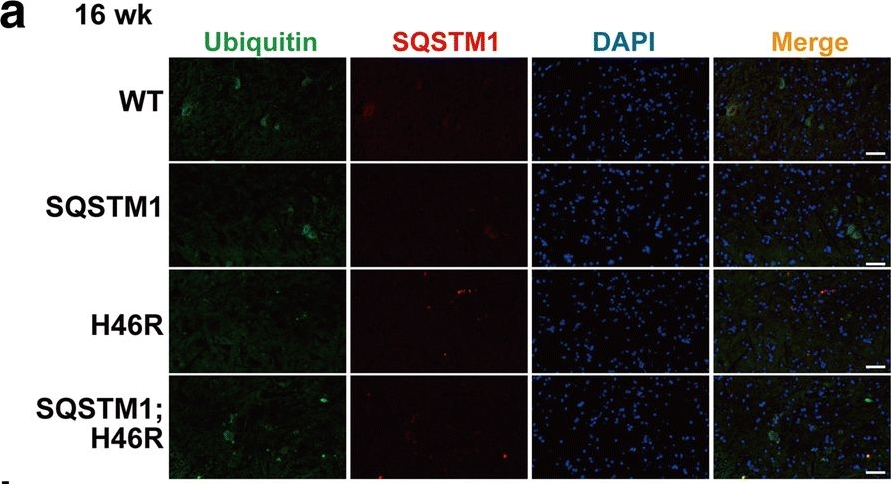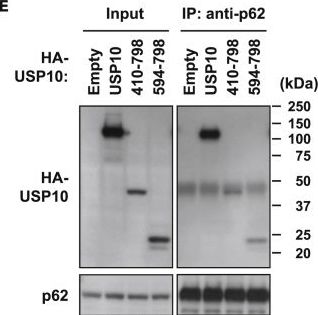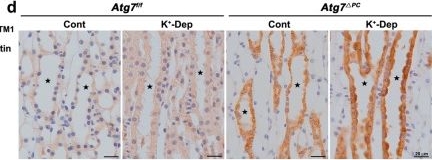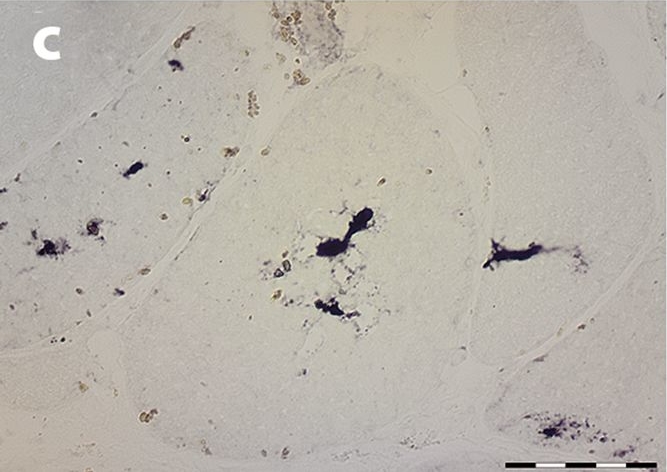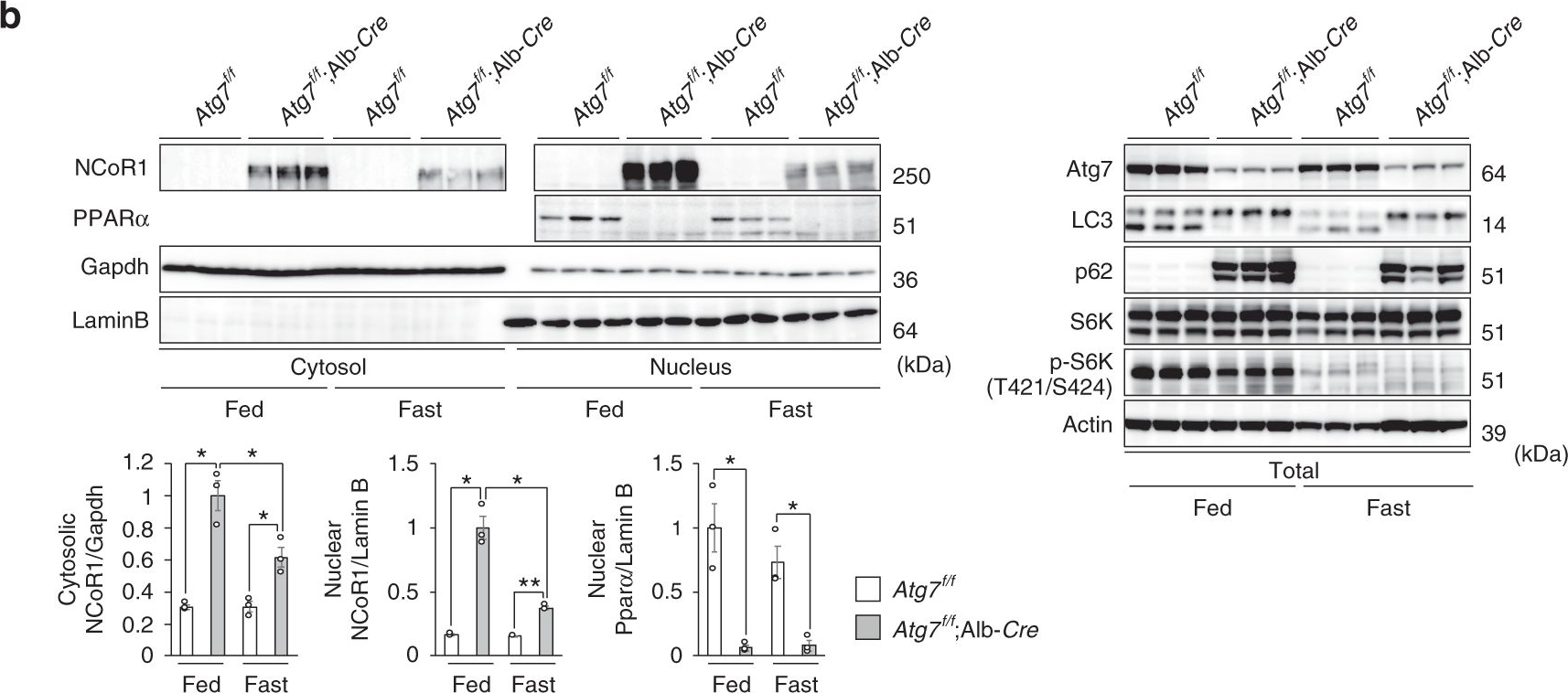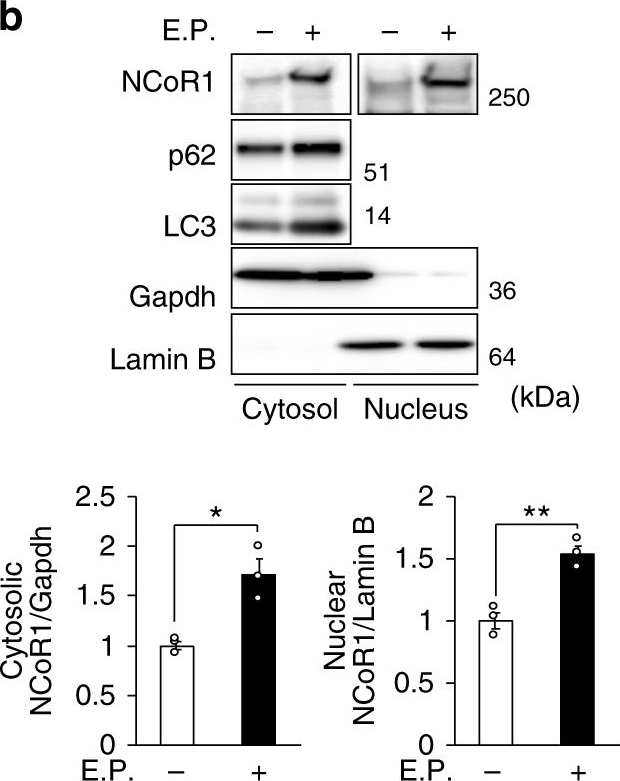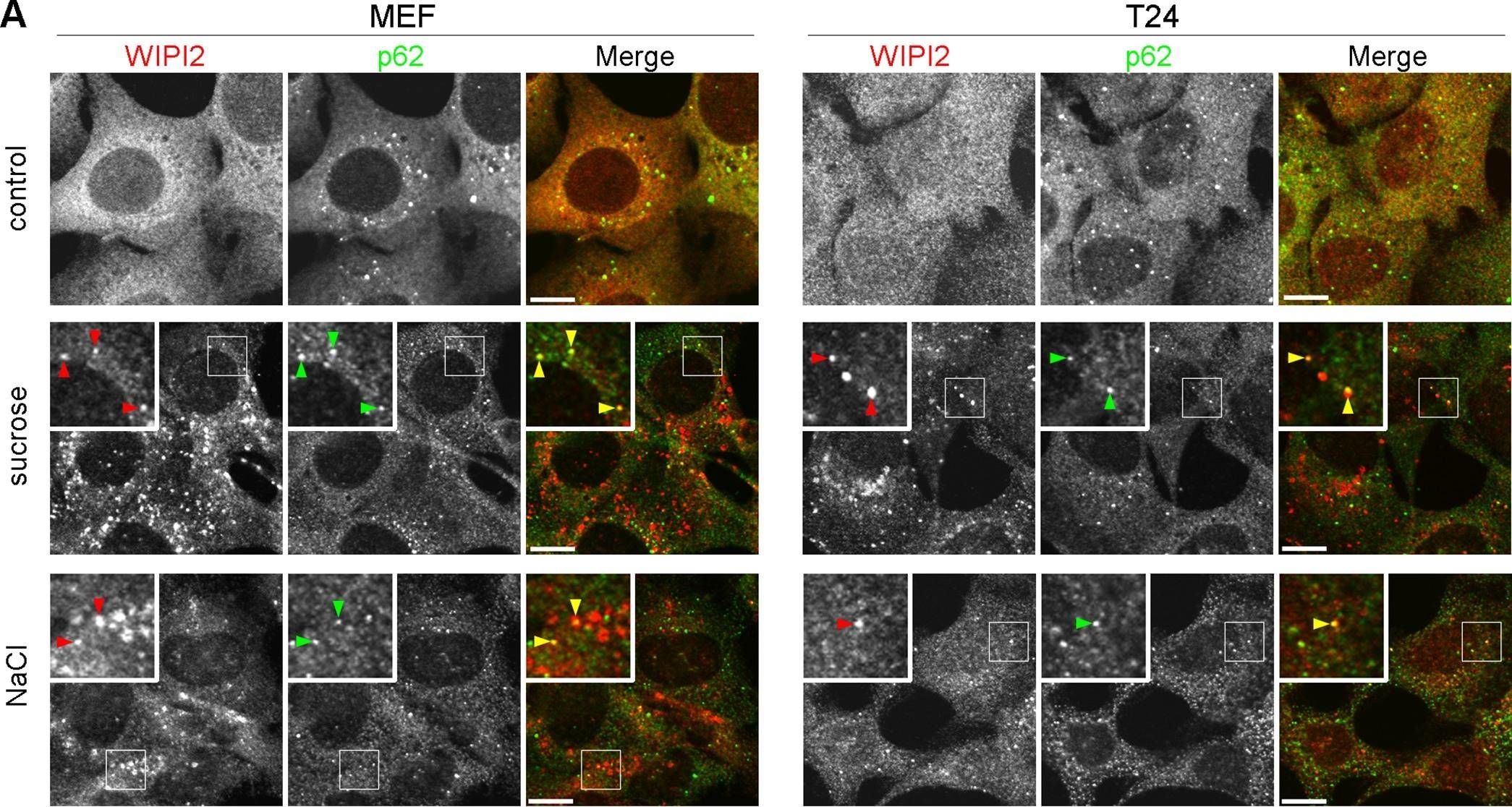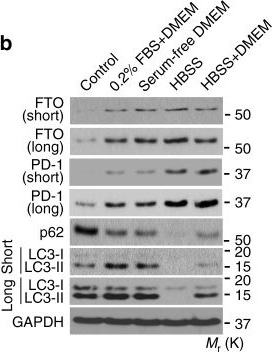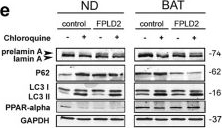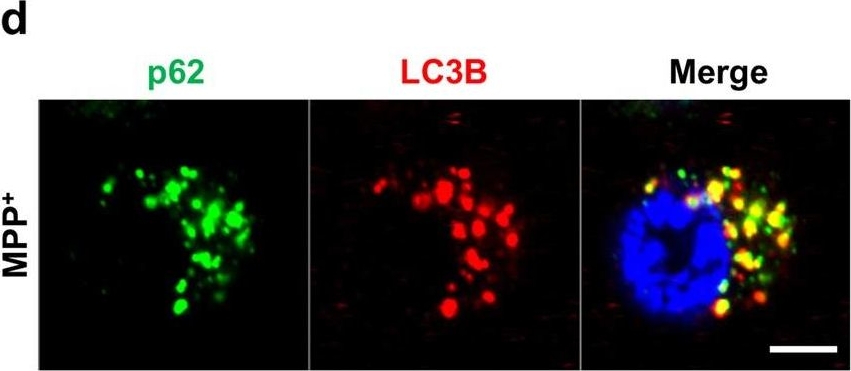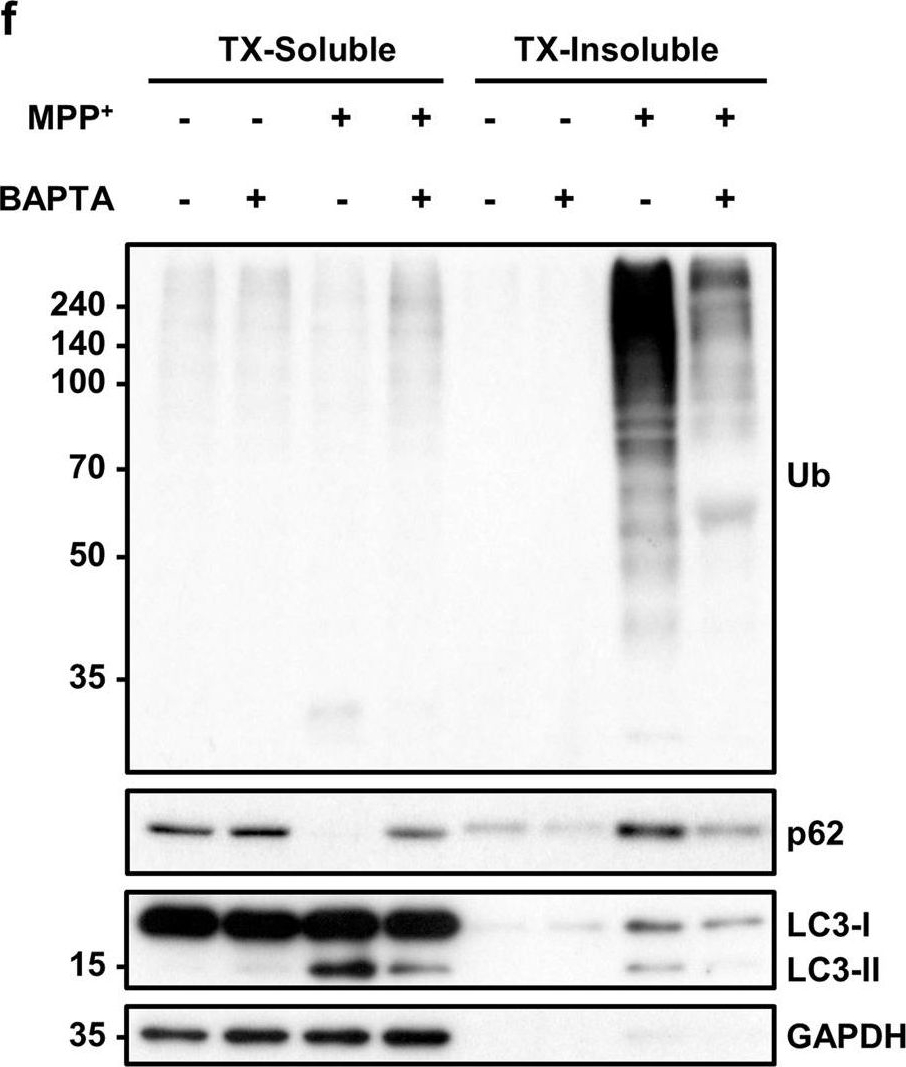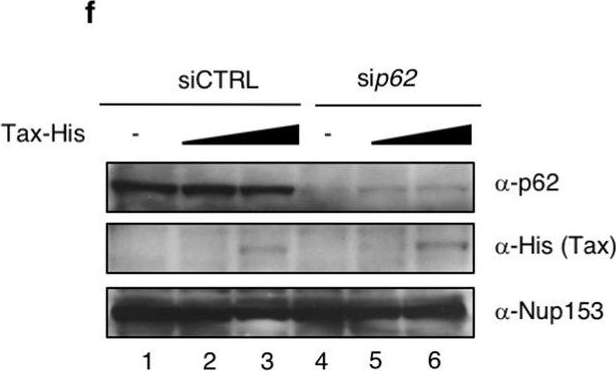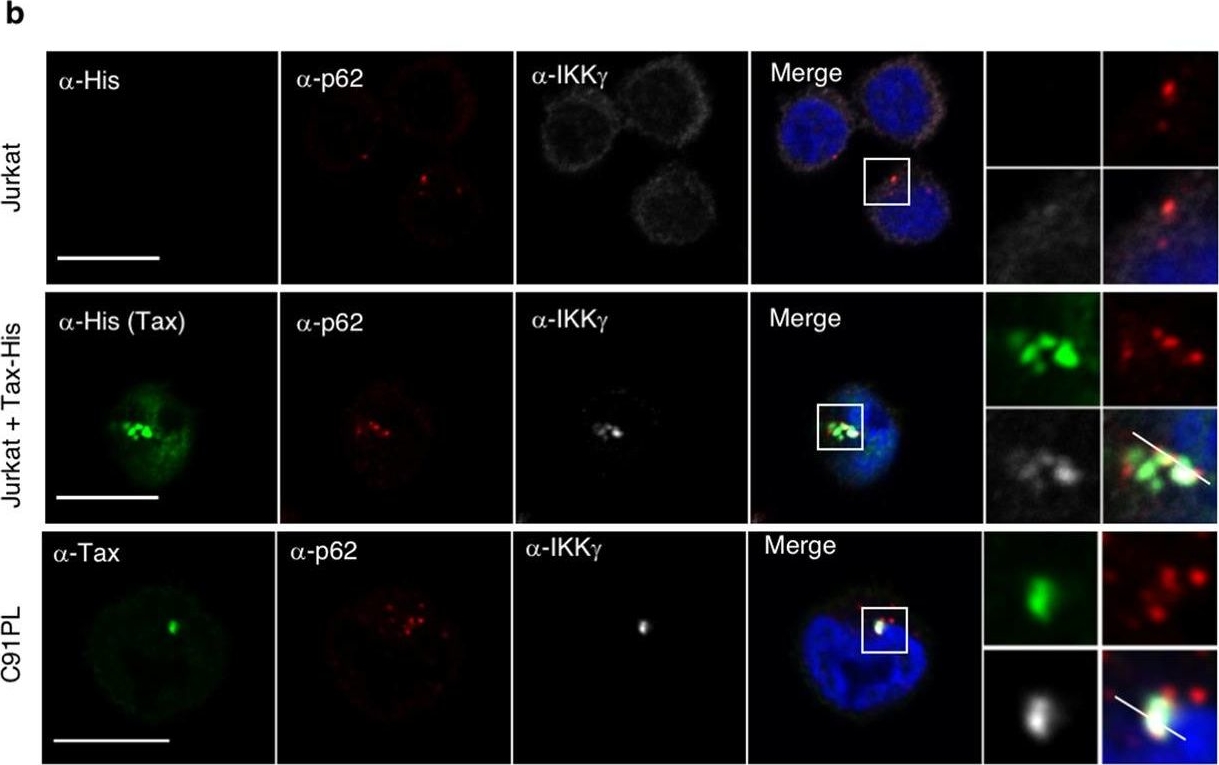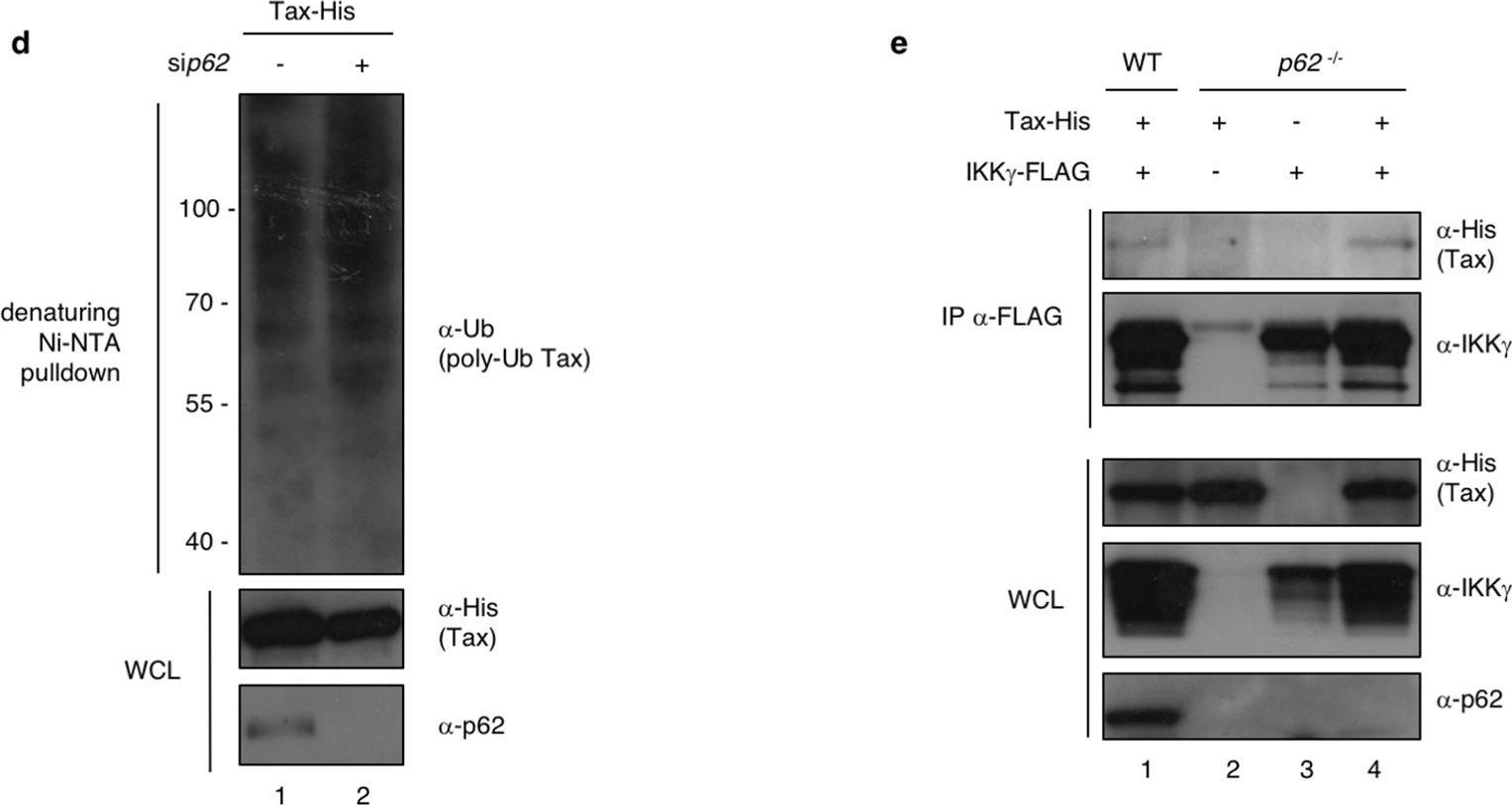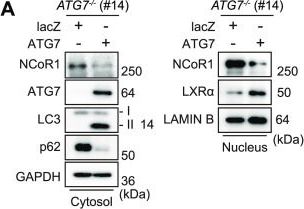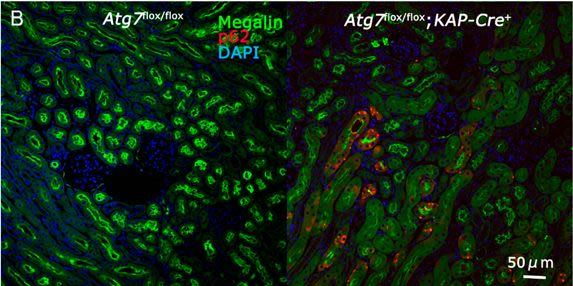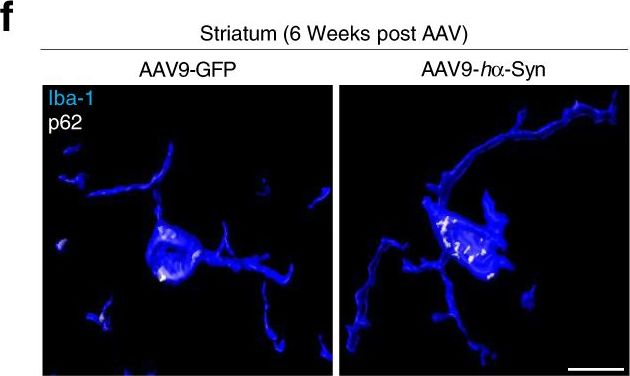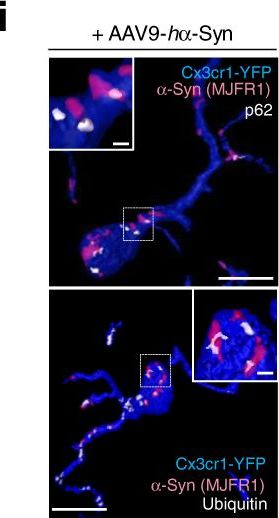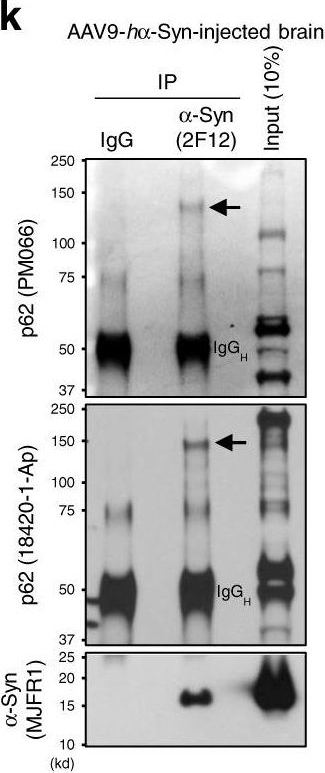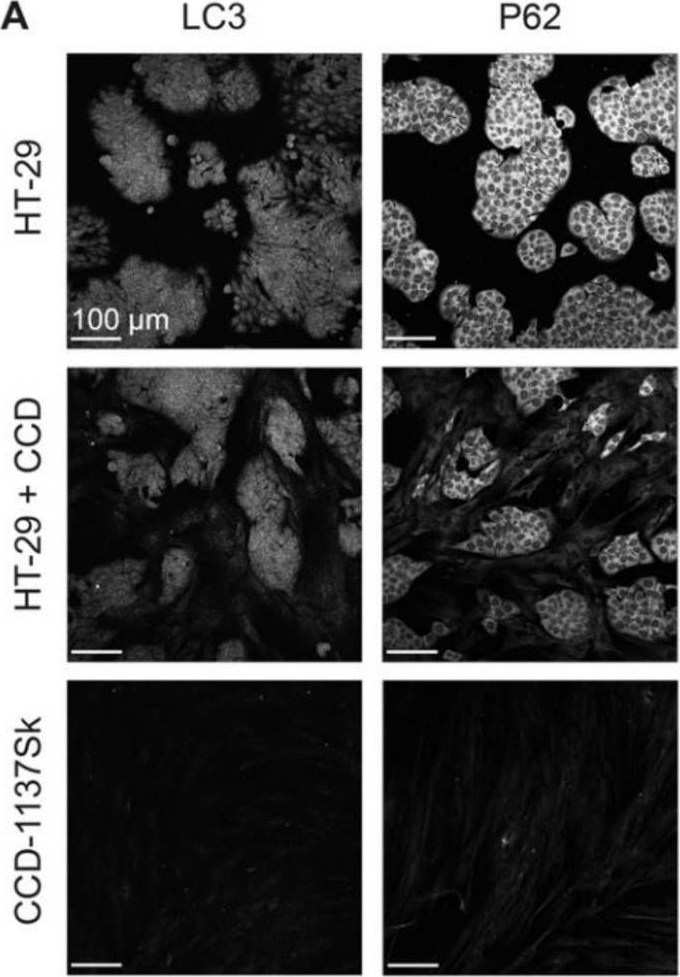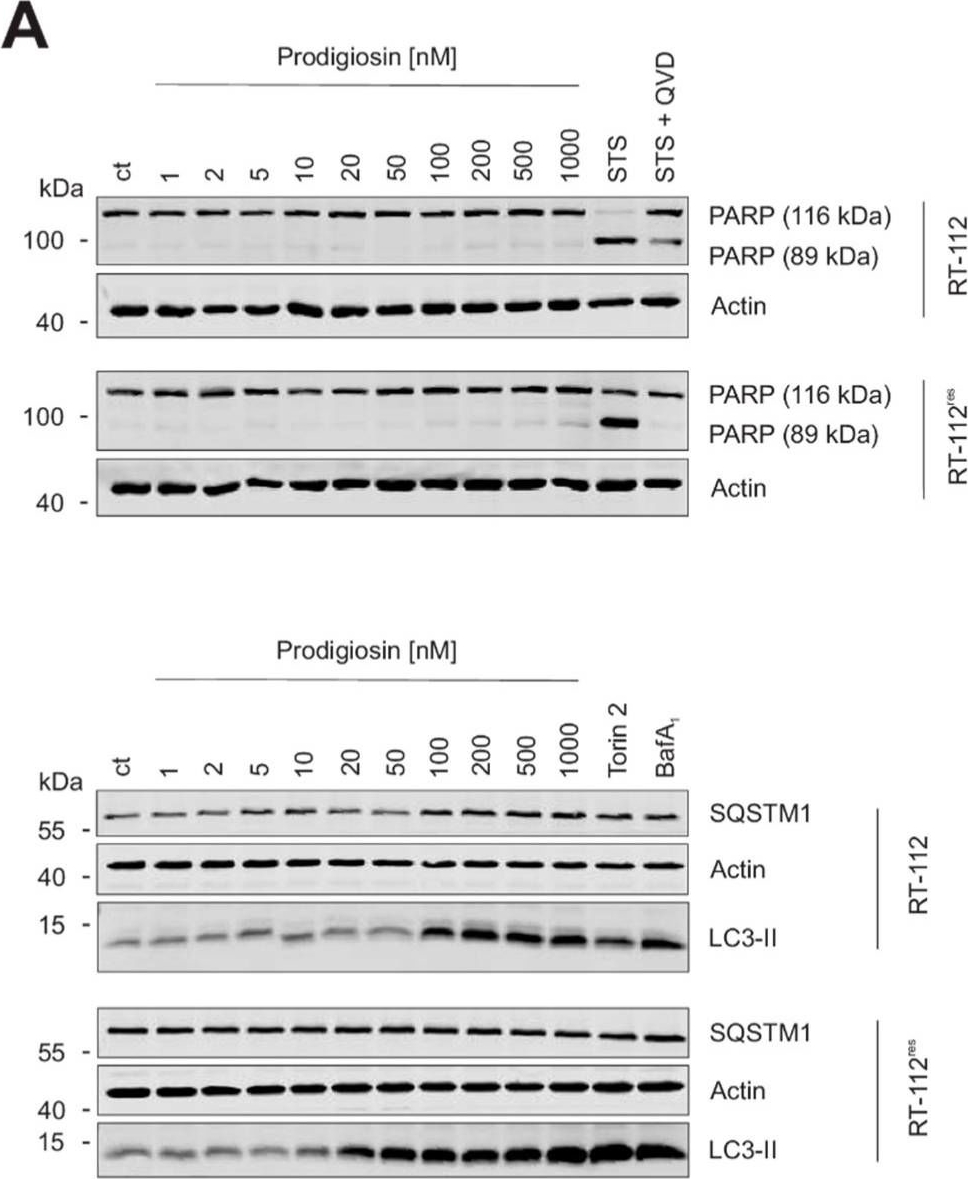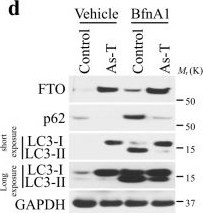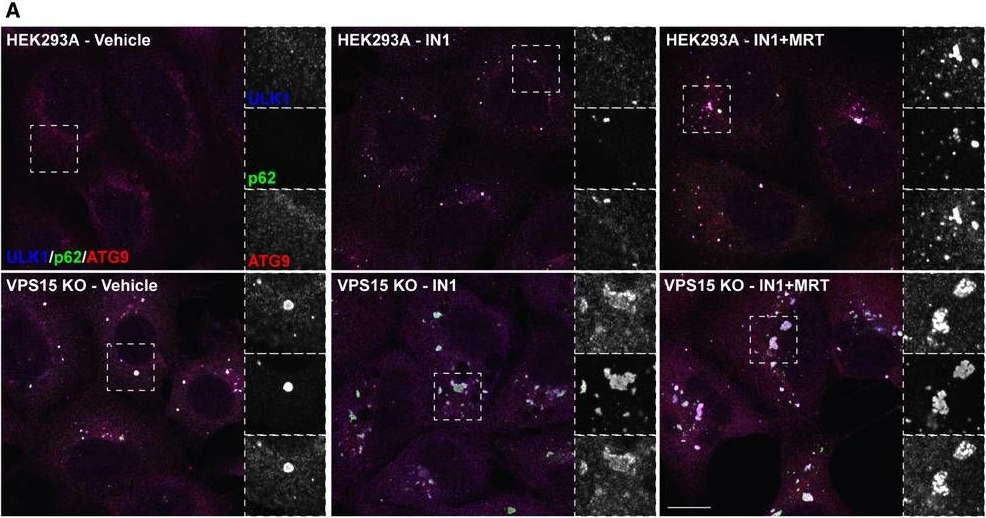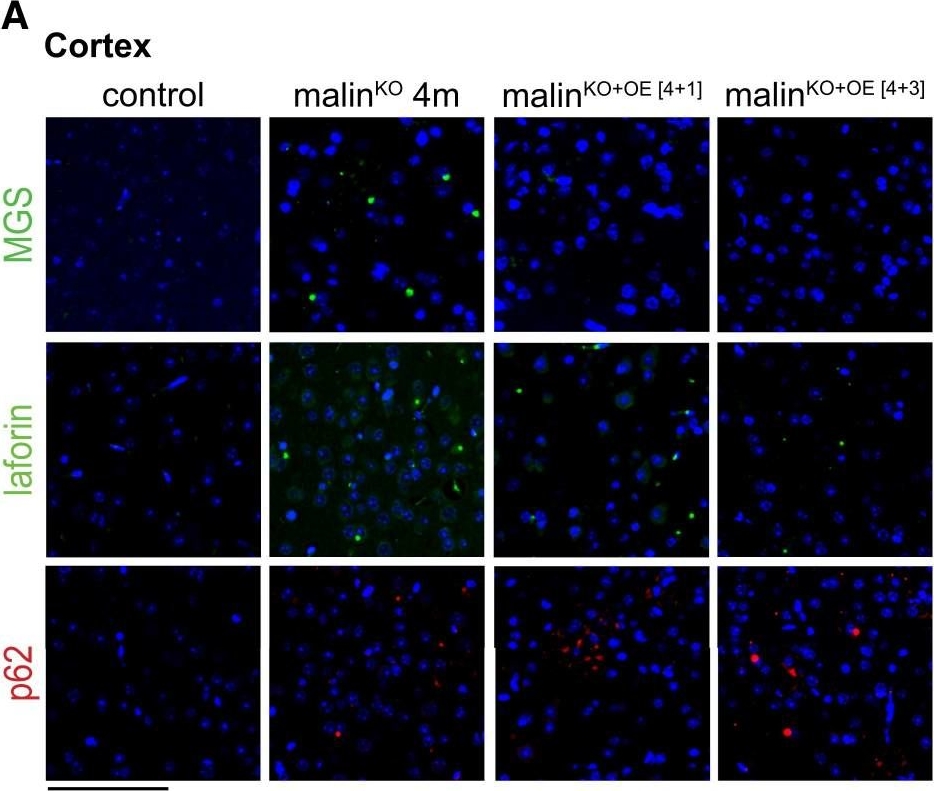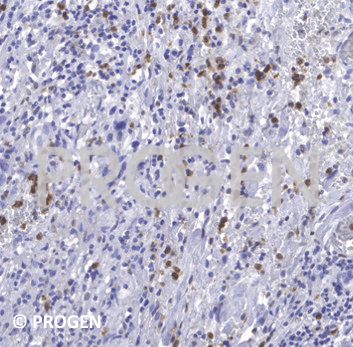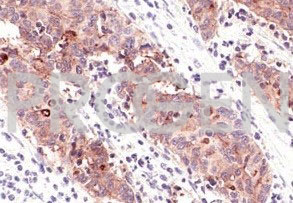Highly published
anti-p62/ SQSTM1 (C-terminus) guinea pig polyclonal, serum
Key Features
- Guinea pig polyclonal
- Suitable for IHC and WB
- Reacts with bovine, human, mouse and rat
Product description
| Quantity | 100 µl |
|---|---|
| Antibody Type | Polyclonal |
| Host | Guinea pig |
| Conjugate | Unconjugated |
| Application | IHC, WB |
| Purification | Stabilized antiserum |
| Reactivity | Bovine, Human, Mouse, Rat |
| Storage | Short term at 2-8°C; long term storage in aliquots at -20°C; avoid freeze/thaw cycles |
| Intended use | Research use only |
| Immunogen | C-terminal domain (20 amino acids: C-NYD IGA ALD TIQ YSK HPP PL) of human p62 protein, coupled to KLH. This peptide sequence is identical in human, monkey, bovine, mouse, and rat. |
| Formulation | Contains 0.09% sodium azide |
| Note | Centrifuge prior to opening |
Applications
| Tested applications | Tested dilutions |
|---|---|
| Immunohistochemistry (IHC) - frozen | 1:100-1:600 |
| Immunohistochemistry (IHC) - paraffin | 1:100-1:600 (microwave treatment recommended) |
| Western Blot (WB) | 1:1,000-1:3,000 |
Background
Human 62 kDa (p62) protein, is present in intracytoplasmic inclusions (e.g. hyaline bodies) of hepatocellular carcinoma.
p62 protein (also described as ubiqutin-binding protein; sequestosome 1; SQSTM1) has been found in many tissues and cells, including lymphoid cells, serving probably a common cellular signal transduction mechanism (e.g. ubiquitin-associated degradation and autophagy).
The antiserum stains also neurofibrillary tangles in the brain of patients suffering from Alzheimer's disease.
The GP62-C antibody is knockout validated (Waguri & Komatsu, 2009).
References/Publications (253)
Publication
Species
Application
Species
mouse
Application
IHC
Species
mouse
Application
IHC/IF
Species
Human
Application
IHC-IF
Species
Mouse
Application
IHC
Species
human, mouse
Application
WB
Publication
Kataura, T. et al. NDP52 acts as a redox sensor in PINK1/Parkin‐mediated mitophagy. EMBO J. e111372 (2022).
Species
human
Application
WB
Species
Human
Application
EM
Species
mouse
Application
IHC-IF (paraffin)
Species
Mouse
Application
IHC
Species
human
Application
ICC, WB
Species
Mouse
Application
IHC-IF
Species
Human
Application
WB
Species
Mouse
Application
IHC-IF
Species
rat
Application
WB
Species
human
Application
WB
Species
Mouse
Application
IHC-Fr-IF
Species
human
Application
ICC-IF, WB
Species
mouse
Application
IHC-IF
Species
human
Application
WB
Species
mouse
Application
WB
Species
human
Application
ICC-IF, WB
Species
human
Application
WB
Species
human
Application
WB
Species
Mouse
Application
IHC-IF
Species
Human
Application
WB
Species
macaque
Application
IHC (paraffin)
Species
Mouse
Application
IHC-P
Species
mouse
Application
ICC/IF
Species
mouse
Application
IHC-IF
Species
human
Application
WB
Species
Human
Application
WB
Species
human
Application
ICC
Species
human
Application
ICC/IF
Species
rat
Application
WB
Species
human
Application
ICC-IF, WB
Species
human
Application
WB
Species
human
Application
IHC (paraffin)/IF
Species
human
Application
WB
Species
mouse
Application
WB
Species
rat
Application
WB,IHC-IF (paraffin)
Species
mouse
Application
WB
Species
human
Application
ICC-IF, WB
Species
mouse
Application
IHC/IF
Species
mouse
Application
WB
Species
mouse
Application
IHC-IF
Species
mouse
Application
IHC/IF
Species
mouse
Application
ICC-IF
Species
human
Application
WB
Species
mouse
Application
WB
Species
human
Application
WB
Species
human,mouse
Application
WB
Species
mouse
Application
ICC
Species
mouse
Application
IHC (paraffin)
Species
human
Application
WB,ICC-IF
Species
rat
Application
WB,IHC (paraffin)
Species
mouse
Application
WB
Species
human
Application
WB,IHC,IP
Species
mouse
Application
WB
Species
mouse
Application
WB,ICC-IF
Species
human
Application
WB
Species
mouse
Application
WB
Species
human
Application
WB
Species
mouse
Application
WB
Species
human
Application
WB
Species
mouse
Application
IHC (paraffin)
Species
human,mouse
Application
WB,ICC
Species
mouse
Application
IHC (paraffin)
Species
mouse
Application
WB
Species
human
Application
WB
Species
mouse
Application
WB,IHC-IF (frozen)
Species
human
Application
WB
Species
mouse
Application
ICC-IF,WB
Species
human
Application
WB
Species
mouse
Application
IHC (paraffin)
Species
mouse
Application
IHC-IF (frozen)
Species
human
Application
ICC-IF
Species
mouse
Application
IHC-IF (paraffin)
Species
mouse
Application
WB
Species
mouse
Application
ICC
Species
human
Application
WB
Species
mouse
Application
WB
Species
human
Application
ICC-IF
Species
mouse
Application
IHC (paraffin)
Species
human
Application
IHC (paraffin)
Species
rat
Application
WB
Species
mouse
Application
IHC (paraffin)
Species
mouse
Application
ICC
Species
mouse
Application
IHC-IF (paraffin)
Species
mouse
Application
WB
Publication
Sabino, C. et al. Bafilomycin A1 and U18666A Efficiently Impair ZIKV Infection. Viruses. 11, (2019)
Species
human
Application
WB
Species
pig
Application
IHC (paraffin)
Species
mouse
Application
WB
Species
mouse
Application
IHC (frozen)
Species
mouse
Application
WB
Species
human
Application
ICC-IF
Species
mouse
Application
ICC-IF
Species
mouse
Application
WB
Species
mouse
Application
WB
Species
human
Application
IHC (frozen)
Species
human
Application
IHC (paraffin)
Species
mouse
Application
WB,IHC (paraffin)
Species
mouse
Application
ICC-IF
Species
human
Application
IF,WB
Species
mouse
Application
WB
Species
human
Application
IHC-IF (frozen)
Species
mouse
Application
IHC (frozen)
Species
mouse
Application
IHC-IF (paraffin)
Species
mouse
Application
WB
Species
human
Application
ICC-IF
Publication
Ogmundsdóttir, M. et al. A short isoform of ATG7 fails to lipidate LC3/GABARAP. Sci.Rep. 8, 14391 (2018).
Species
mouse
Application
WB
Species
human
Application
WB
Species
human
Application
WB
Species
mouse
Application
WB,IHC-IF (frozen)
Species
human
Application
WB
Species
human,mouse
Application
WB
Species
mouse
Application
IHC (paraffin)
Species
mouse
Application
WB
Species
mouse
Application
IHC-IF (paraffin)
Species
human
Application
WB
Species
mouse
Application
WB
Species
human
Application
WB
Species
human
Application
WB,ICC-IF
Species
drosophila
Application
WB
Species
human
Application
WB
Species
human
Application
WB,ICC-IF
Species
human
Application
IHC-IF (paraffin)
Species
mouse
Application
IHC (frozen)
Species
human
Application
IHC (paraffin)
Species
mouse
Application
WB
Species
mouse
Application
ICC-IF
Species
rat
Application
WB
Species
mouse
Application
WB
Species
mouse
Application
ICC-IF
Species
mouse
Application
WB
Species
human,mouse
Application
WB,ICC-IF
Species
mouse
Application
WB
Species
mouse
Application
ICC
Species
mouse
Application
WB
Species
human
Application
WB,ICC-IF
Species
mouse
Application
WB
Species
human
Application
ICC-IF
Species
human,mouse
Application
WB,IHC (paraffin),ICC-IF
Species
mouse
Application
WB,ICC-IF
Species
pig
Application
ICC-IF
Species
human
Application
WB
Species
mouse
Application
WB
Species
mouse
Application
WB
Species
mouse
Application
IHC (frozen)
Species
mouse
Application
WB
Species
mouse
Application
IHC (paraffin)
Species
mouse
Application
IHC-IF (frozen)
Species
human
Application
ICC-IF
Species
human
Application
ICC-IF
Species
mouse
Application
WB
Species
human,chicken
Application
IHC (frozen),ICC-IF
Species
mouse,rat
Application
WB
Species
rat
Application
WB
Species
human
Application
WB
Publication
Lee, M. Y. et al. Peroxisomal protein PEX13 functions in selective autophagy. EMBO Rep. 18, 48–60 (2017).
Species
mouse
Application
WB
Species
mouse
Application
ICC-IF
Species
mouse
Application
IHC-IF (paraffin)
Species
mouse
Application
WB
Species
monkey
Application
ICC-IF
Species
human,mouse
Application
WB,IHC (frozen),ICC-IF
Species
human
Application
ICC-IF
Species
human
Application
WB,IHC (frozen)
Species
mouse
Application
WB
Species
human
Application
WB
Species
human
Application
WB
Species
human
Application
WB
Species
human
Application
WB,IHC (frozen)
Publication
Gómez-Sintes, R. et al. Standard Assays for the Study of Autophagy in the Ex Vivo Retina. Cells. 6, (2017)
Species
mouse
Application
ICC-IF
Species
human
Application
WB
Species
mouse
Application
ICC-IF
Species
mouse
Application
WB
Species
human
Application
WB,IHC (frozen)
Species
mouse
Application
WB,ICC-IF
Species
mouse
Application
WB
Species
mouse
Application
WB,IHC (frozen)
Species
human,mouse
Application
WB,IHC (paraffin)
Species
human,mouse
Application
WB,ICC-IF
Species
mouse
Application
IHC-IF
Species
mouse
Application
WB
Species
human
Application
WB
Species
human
Application
WB
Species
human
Application
WB
Species
human
Application
WB
Species
mouse
Application
IHC (frozen),ICC-IF
Species
human,mouse
Application
WB,ICC-IF
Species
human,mouse
Application
WB,IHC (frozen)
Species
rat
Application
WB
Species
rat
Application
WB,IHC (paraffin)
Species
mouse
Application
WB
Species
human
Application
IHC (frozen)
Species
human,mouse
Application
WB,ICC-IF
Species
rat
Application
WB
Species
mouse
Application
WB,ICC-IF
Species
human
Application
WB
Species
human
Application
WB
Species
human
Application
WB
Species
mouse,rat
Application
WB
Species
human
Application
WB
Species
rat
Application
WB
Species
mouse
Application
WB,ICC-IF
Species
mouse
Application
IHC (paraffin)
Species
human
Application
WB,ICC-IF
Species
human
Application
ICC-IF
Species
mouse
Application
WB
Species
human,mouse
Application
WB,ICC-IF
Species
mouse
Application
WB
Species
mouse
Application
WB
Species
human
Application
WB
Species
mouse
Application
WB
Species
rat
Application
WB,IHC (frozen)
Species
human
Application
WB
Species
mouse
Application
IHC (frozen)
Species
human
Application
WB
Species
mouse
Application
WB
Species
mouse
Application
ICC-IF
Species
mouse
Application
IHC (paraffin),IEM
Species
mouse
Application
WB
Species
monkey
Application
WB,ICC-IF
Species
mouse
Application
WB
Species
mouse
Application
IHC (paraffin)
Species
mouse
Application
ICC-IF
Species
mouse
Application
WB,IHC (paraffin)
Species
mouse
Application
WB,IHC (frozen),IEM
Species
mouse
Application
WB,IHC (paraffin),ICC-IF,IP
Species
mouse
Application
IHC (frozen)
Species
mouse
Application
WB,IHC (paraffin)
Species
human,mouse
Application
WB,IHC
Species
mouse
Application
WB,ICC-IF
Species
mouse
Application
WB
Species
human
Application
WB,ICC-IF
Species
mouse
Application
WB
Species
mouse
Application
WB,IHC (frozen)
Species
human
Application
WB
Species
human,mouse
Application
WB
Species
human
Application
WB
Species
mouse
Application
WB,IHC
Species
mouse
Application
WB
Species
mouse
Application
WB
Species
mouse
Application
WB
Species
mouse
Application
IHC (frozen)
Species
human
Application
WB,IHC
Species
mouse
Application
WB
Species
mouse
Application
WB
Species
mouse
Application
ICC-IF
Publication
Yamano, K. & Youle, R. J. PINK1 is degraded through the N-end rule pathway. Autophagy 9, 1758–69 (2013).
Species
human
Application
ICC-IF
Species
mouse
Application
WB,ICC-IF,IEM
Species
human,mouse
Application
WB
Species
mouse
Application
WB
Species
mouse
Application
WB,IHC (frozen)
Downloads
File
Category
Size
Filetype
Q & A's
There aren't any asked questions yet.
Customer Reviews
Login
FAQs
- PVDF membranes show better results than nitrocellulose (higher capacity, allows for more stringent washing conditions in case of background problems).
- Use freshly prepared blocking solution (e.g. 5% nonfat dry milk, 0.05% Tween 20), block for at least 1 h at room temperature.
- Use the antibody in a higher dilution, but prolong incubation time and exposure time.
- Always use a fresh aliquot of the antibody.
- Do not repeatedly freeze the antibody (eventually centrifuge shortly after thawing to remove cryo-precipitates).
- Include an additional washing step.
You might also try more stringent wash conditions, e.g. add 0.5 M NaCl to the wash buffer. - Always use a fresh aliquot of secondary antibody.
- In case you use ECL most the guinea pig antibody should be diluted further in order to get rid of the background.
Most of our purified mouse antibodies contain 0.5% BSA as stabilizer. If BSA was added to the antibody solution, it is stated in the datasheet.
The supernatant format contains FCS proteins from cell culture medium supplemented with FCS.
The serum antibodies contain other proteins present in serum.
The supernatant format contains FCS proteins from cell culture medium supplemented with FCS.
The serum antibodies contain other proteins present in serum.
Lyophilized antibodies can be stored at 2-8°C until expiration.
Most of our liquid antibodies and reconstituted lyophilized antibodies may be stored for short term storage (up to 3 month) at 2-8°C. For long term storage we recommend to store the antibody at -20°C in aliquots. Please avoid freeze and thaw cycles.
Most of our conjugated antibodies should be stored at 2-8°C.
The individual storage conditions are mentioned on the datasheet.
Most of our liquid antibodies and reconstituted lyophilized antibodies may be stored for short term storage (up to 3 month) at 2-8°C. For long term storage we recommend to store the antibody at -20°C in aliquots. Please avoid freeze and thaw cycles.
Most of our conjugated antibodies should be stored at 2-8°C.
The individual storage conditions are mentioned on the datasheet.
The expiration date of our antibodies is indicated on the product label.
- Methanol/ acetone fixation: Immerse slide in precooled (-20°C) methanol for 5 min, immerse in precooled (-20°C) acetone for 30-60 sec, let specimen air dry before antibody incubation.
- Methanol/ acetone fixation plus detergent permeabilization: After methanol/ acetone fixation and air-drying dip slide either in a solution containing 0.1-0.2% Triton X-100 in PBS or in 0.1% saponin in PBS for 1-5 min at room temperature (enhances accessibility of many cytoskeletal antigens).
- Air-drying of the section.
- Block with the serum of the species in which the secondary antibody was raised for 30 min.
- Incubation with 1st antibody 1 h at RT in moist chamber.
- Wash 3x with PBS.
- Incubation with appropriate fluorescent secondary antibody, 30-60 min at RT.
- Wash 3x with PBS.
- Immerse shortly into ethanol.
- Let air dry.
- Cover with mounting medium.
Most of our antibodies contain 0.09% sodium azide as preservative. If a preservative is added, it is mentioned in the datasheet.
The optimal antibody dilution for your specific protocol and application needs to be titrated in your lab with your equipment and sample. The optimal dilution may vary between protocols and samples. A good dilution for starting the titration is the dilution mentioned in the datasheet. If the sample needs a specific treatment (eg. Antigen retrieval for IHC on FFPE sections) this should also be mentioned on the antibody datasheet.
PROGEN antibodies are shipped at ambient temperature. The antibodies are stable at ambient temperature for the shipment period. Please store the antibodies as indicated in the datasheet upon arrival.
The concentration of specific antibody in our guinea pig serum is not determined.
In guinea pigs the antibody concentration in serum varies from 10 to 20 mg/ml; specific antibodies represent normally about 0.1-1% of total IgG. Total protein concentration varies from 40 to 65 mg/ml, with the main constituent (about 60%) being albumin.
In guinea pigs the antibody concentration in serum varies from 10 to 20 mg/ml; specific antibodies represent normally about 0.1-1% of total IgG. Total protein concentration varies from 40 to 65 mg/ml, with the main constituent (about 60%) being albumin.



